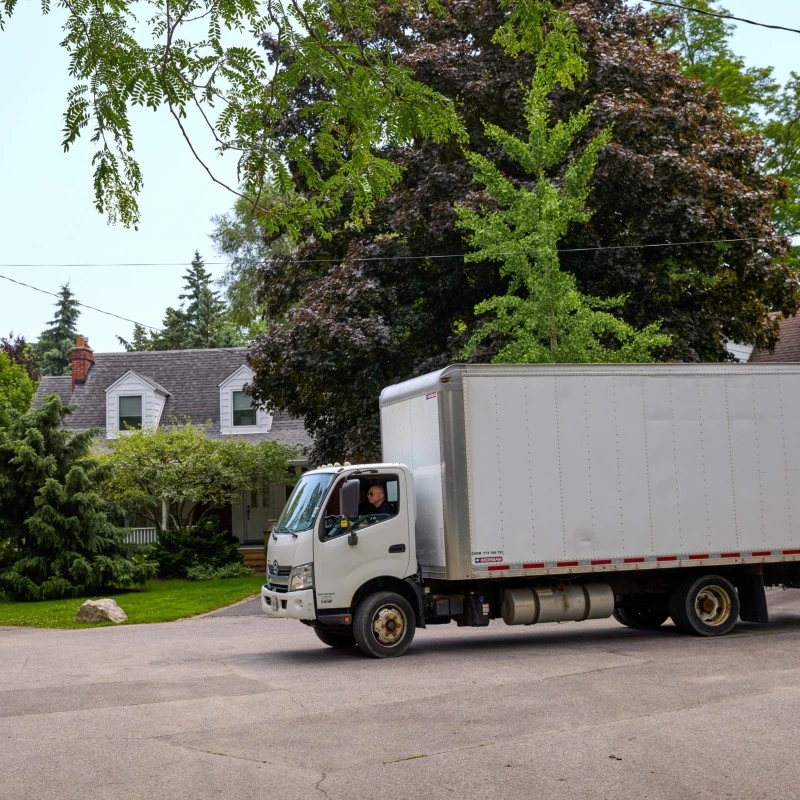Moving checklist and relocation guide for Toronto


Canada’s biggest city is an exciting destination—whether you are moving for work opportunities, studying or to be closer to your family. Toronto’s metropolitan and multicultural neighbourhoods bring diversity and offer a lot to explore.
Like any major life event, making the move and settling in is best done with adequate planning and preparation. With the right approach, your moving day will run smoothly and quickly.
This guide is your moving-day digital best friend—here to provide support and guidance throughout the entire moving process, including checklists, budgeting tips, packing guidelines, and more.
Let’s dive in.
Introduction to moving house in Toronto

Toronto is a hectic city on a normal day, and moving houses adds another layer of detail and action. Moving at the end of the month, or during summer months can make it even busier.
Expect traffic congestion to slow you down, especially during rush hours (7 am – 10 am and 4 pm – 7 pm). Plan your route to expedite your trips and avoid the busiest intersections. Parking can also be tricky, especially in the downtown core. Consider getting a temporary parking permit to simplify things during the move.
Depending on the season, you may be dealing with heat waves or sudden downpours, so prepare accordingly.
Worry not–there are some positive aspects to moving day in Toronto. The city has numerous moving companies to choose from. Do your research to find the most affordable and reliable movers in Toronto to meet your exact moving needs—no matter how specific. Also, a city of this size guarantees that online mapping apps are constantly updated, allowing you to plan your route for maximum efficiency in the moment.
Tips for managing the moving process

-
Determine your budget. Research Toronto moving companies, and book your move as early as possible.
-
Plan a route while considering roads, major intersections, and public transit routes. A mapping app like Google Maps or Waze will update accidents and road construction in real time.
-
Take note of narrow hallways and any staircases in your old and new homes—let your movers know about them before moving day.
-
Take care of admin details sooner rather than later. For example, update your address with utility and service providers. If you are changing municipalities, you will have to adjust your information for your new municipality.
Things to keep in mind when moving to Toronto
Housing

Finding housing in Toronto is expensive and very competitive—you'll need to find out how much you'll need to earn to live comfortably and afford housing here. There’s also a housing shortage. Act fast if you find a place that suits you and your budget.
Affordable Toronto neighbourhoods
- Rexdale-Kipling
-
West Hill
-
Parkdale
-
St. James Town
-
Allenby
-
Rouge
-
York University Heights
-
Mount Dennis
-
Cliffside
-
Humber Summit
Transport
 Toronto’s public transport is efficient and more affordable than having a car. There are 4 subway lines. The GO Transit system provides regional train and bus services connecting Toronto with surrounding areas, including the Greater Toronto Area (GTA) and beyond.
Toronto’s public transport is efficient and more affordable than having a car. There are 4 subway lines. The GO Transit system provides regional train and bus services connecting Toronto with surrounding areas, including the Greater Toronto Area (GTA) and beyond.
Weather
 Toronto has hot, humid summers and cold, snowy winters. The shoulder seasons are the most pleasant, therefore, they are the most comfortable seasons for moving.
Toronto has hot, humid summers and cold, snowy winters. The shoulder seasons are the most pleasant, therefore, they are the most comfortable seasons for moving.
Cost of living
Toronto is expensive to live in—Canada’s second most expensive city. When determining your Toronto cost of living factor in housing, food, transportation and any specific lifestyle costs.
Toronto moving checklist & timeline
10+ Weeks before your move

-
Get to know Toronto on a whole new level. Even if you are familiar with Toronto's neighbourhoods, there are always new spots to explore. Ask yourself if you would rather live in the downtown core or one of the surrounding areas. Factor in commuting time if you work outside the home. Areas like Kensington Market are hip and fun, but further outside the city may be more affordable or better for families.
-
Determine a realistic budget by factoring in your moving company costs, packing materials, utility setup fees, and if you need to take any time off work.
-
Once you’ve researched moving companies in Toronto. Read reviews, check their insurance and compare quotes. Book your chosen movers early to ensure they are available for your moving date.
-
Look into Toronto storage units if you need to store anything temporarily.
-
Declutter and minimise your packing. Use moving time as motivation to sort through your belongings and donate or sell anything that you don’t love or need.
-
Make a packing plan. By planning ahead of moving day, you ensure adequate time to make arrangements and source proper packing supplies.
-
Give proper notice to your landlord—60 days before moving day is the standard in Toronto and much of Canada.
6+ Weeks before your move

-
Start by packing things that you don’t use often.
-
Consider which packing supplies you will need and place an order.
-
Update your utilities and services with your new address.
-
Change your address with Canada Post, banks and subscription services.
-
Sort your valuable and delicate items. Things like heirloom dishes, art, electronics and antiques need careful packing.
-
Check to see if you need a parking permit at your new place; if so, you will also need one for the moving truck.
4+ Weeks before your move
-
Confirm your moving day and delivery details with your moving company.
-
Book cleaning services if you don’t plan on doing it yourself.
-
If you are moving with pets or kids, organise proper care for them on the big day so you can focus on the move.
-
Check your new home for any needed repairs or cleaning.
2+ Weeks before your move

-
Continue to pack up your belongings.
-
Set aside a moving day bag for essentials—stuff like your toiletries, a change of clothes, and important documents.
-
Update details for your driver’s license, car registration and electoral roll.
1 Week before you move
-
Make a plan and confirm parking, logistics and the itinerary for moving day with your moving company.
-
Finish deep cleaning your old house.
-
Pack up your remaining items.
- Schedule child or pet care
-
Stop watering your larger plants to make them lighter on your moving day.
Moving day

-
Reserve a parking spot for the moving truck—especially if you are moving to or from a busy area.
-
Get out of your movers' way and let them handle the heavy lifting (they are the professionals, after all).
-
Do a final run-through of every room to check that you haven’t left anything behind.
-
Begin settling into your new place.
After the move
-
Unpack the essentials first. Get your bedroom, kitchen and bathroom set up so that your days go smoothly right off the bat.
-
Confirm the delivery is complete—make sure all your boxes and furniture are in the appropriate rooms of your new home.
-
Walk around the neighbourhood to get familiar.
Budgeting for movers in Toronto
 Your moving day costs will vary depending on how big your house is and how far the movers have to travel.
Your moving day costs will vary depending on how big your house is and how far the movers have to travel.
The average rates to move the contents of a 1-bedroom apartment in Toronto fall between CA$300 and CA$750. On the opposite end of the scale, to move the contents of a 4-bedroom house can be anywhere from CA$4500 and CA$7000.
If you are moving into a Toronto property you’ve purchased, account for all the extra expenses such as legal fees, inspections and conveyancing related to Canadian real estate. Sellers also have costs such as advertising and real estate commissions.
If you're moving into a rental, factor in the damage deposit and smaller costs, such as setting up utilities, buying packing supplies, and paying for parking permits if needed.
Pros and cons of hiring movers vs. DIY movers
Whether you want to hire moving help or do it yourself really depends on your budget, time constraints, and physical capabilities. There are pros and cons to both options
Hiring professional movers in Toronto

Pros
-
Fast and efficient: Professional movers have dialled the moving process to be smooth and seamless.
-
Less stress: Having movers take care of things like packing delicate items or lifting heavy furniture takes a huge load off your mind and body.
-
Peace of mind: Many Toronto Moving Companies offer insurance coverage. If something goes awry, the costs of replacing or repairing damaged items won’t come out of your pocket.
-
Special handling: Moving companies have the expertise to move tricky items like fragile glassware, artwork, musical instruments, and large furniture. You can breathe easy knowing that your valuables are in good hands when navigating stairs and hallways.
-
Safety: Having movers do the grunt work reduces the risk of personal injury or damaged belongings.
Cons
-
Costs: Hiring professionals or experts for any endeavour inevitably comes with a cost. If you have a large home, hiring movers can end up being costly.
-
Unexpected fees: Moving companies may charge extra for long carries, such as when the truck cannot park close to the front door of your new home. Narrow access points, elevators and stairs may also result in extra fees.
DIY moving
Pros
-
Saves money: If your budget is tight, DIY is the more affordable option. If you don’t have much furniture or stuff in general, moving it all yourself is logical and cost-effective.
-
Total Control: You handle your belongings yourself, which could bring peace of mind to some.
-
Schedule flexibility: You decide when you want to move. Who knows, you may want to take advantage of nighttime or early morning as these hours mean less road traffic.
Cons
-
Time-consuming: There are a lot of steps involved in moving. Packing, loading, driving and unloading can all take a lot of time. Then you still have to unpack and set up your new home on top of that. Not to mention the unexpected hiccups and challenges along the way.
-
Bodily wear-and-tear: Moving is extremely physical, so unless you are burly and able to lift heavy things all day without strain, you risk injury or putting unnecessary wear-and-tear on your body.
-
Risk of damage: Without the expertise and skills of professionals, your packing and moving techniques may not properly protect your belongings, risking damage and broken items.
Assess how much time, energy, money and physical strength you currently have, before deciding whether to hire professionals or do it yourself.
Packing up each room
If you approach packing with a bit of strategy, you can avoid potential chaos and ensure your moving day (and unpacking) goes as smoothly as possible. With a task this big, procrastination is your enemy. Start early and stay organised by labelling everything clearly. Bit by bit, you can accomplish a lot and feel on top of things once you are in your new place.
Outdoor areas: garden shed and storage
- Tools: Go through your collection of tools. If anything is broken or rusted and you don’t feel like you have it in you to restore the tool one day, get rid of it. Remember the saying, Reduce→Reuse→Recycle. Often, there are specific piles for discarded items at your municipal dump, leaving the option for someone else to take the item and breathe new life into it.
- Gather smaller tools into boxes. Larger items like weed wackers, chainsaws and lawnmowers can be wrapped in old blankets for protection.
- Furniture: Outdoor furniture can be disassembled and wrapped in blankets. Make sure it is totally dry.
- Plants and pots: Large potted plants can be moved on their own, while medium and small ones can be packed into a sturdy box. Clay or ceramic pots can be wrapped in fabric so that they don’t bump each other and risk breaking. Produce boxes from the grocery store are usually stapled and can hold a lot of weight.
Guest rooms

- Bedding: The fastest way to pack bedding is to stuff it into bags, boxes or bins. Make sure to label everything so that unpacking is smooth and easy.
- Furniture: If possible, take apart bulky furniture like bed frames. Keep track of hardware and label the little bag or box that you store it in.
Office area
- Paperwork: Sort your documents and papers and recycle anything that you don’t need anymore. Pack really important documents in a separate file box for easy access.
- Electronics: While many use bubble wrap for fragile items, we also recommend plastic-free packing options. Wrap electronics, like computers and printers, in fabrics. If you have the original boxes, use those.
- Furniture: Disassemble your desk, if possible. Small things like office supplies and stationery can be packed into boxes.
Living and dining rooms
- Electronics: The TV, stereo and other gadgets are stored best in their original boxes. If you’ve already thrown these boxes out, wrap them in sheets or blankets to protect them during your move.
- Furniture: To prevent scratches on your sofas and tables, wrap them in moving blankets or furniture pads. Take anything apart that you can to save space and make things easier to move.
- Books and decorations: Smaller boxes or even carry-on suitcases are the best for boxes. This way, you avoid making a box that is too heavy. Wrap fragile decorations in bubble wrap.
- Soft furnishings: Place cushions and throw blankets into large bags or boxes, but don’t stuff them too tightly.
Main bedroom
- Clothes: Wardrobe boxes are great for keeping your hanging clothes from getting wrinkled. Everything else can be folded into suitcases or regular boxes and bags.
- Bedding: Label one or two large boxes for your bedding.
- Furniture: Take apart any large furniture such as bed frames or clothing racks. Store the hardware in sealed bags and label them carefully.
- Personal items: Pack books, gadgets and other small items into smaller boxes, and use dividers for valuables such as watches and jewellery. Wrap framed photos in fabric before packing.
Bathrooms
- Declutter: Get rid of old toiletries, expired medicine and beauty products you no longer use.
- Toiletries: Liquids can be packed into ziplock bags to avoid spills. Put everything into one box so it's easy to find once you get to your new place.
- Fragile items: Wrap mirrors, glass jars or any other delicate bathroom items in fabric before packing them away.
The kitchen

- Declutter: Compost expired or stale food from your cupboards and pantry.
- Dishes and glassware: Mindfully wrap breakables in paper or bubble wrap. Plates and bowls can be stacked together, but glasses are best packed individually with dividers.
- Food: Use up perishable foods before moving–try making big pots of soups and stews to keep you and others fueled during moving week, without having to cook too often. Pack canned and dry goods into small boxes for easy moving.
- Appliances and utensils: Appliances, such as blenders, toasters and kettles, can be wrapped in fabric and packed in large, sturdy boxes. Smaller utensils and cutlery can be placed into smaller boxes with clear labels.
Doing a move-out clean to get that damage deposit back
Now that your packing mission is complete, you can start a deep clean. If you’re renting, you will want to leave your place spotless to get your damage deposit back (usually a full month’s rent). We’ve broken down the move-out cleaning into easy steps to get the space spotless in no time.
Step 1: Work from top to bottom
Clean dust and cobwebs off of ceilings, light fixtures and vents. This way, any dust that falls won’t be on your already clean floors. Be careful on ladders and step stools! Once the ceiling is done, you can wash the walls, windows and window frames.
Step 2: Tackle the kitchen
The kitchen often requires the most elbow grease. Wipe down countertops, sinks, and all appliances. The stove and oven may have tougher grime—make a paste of vinegar and baking soda to scrub anything stubborn. Don’t forget to clean behind the fridge.
Step 3: Make the bathrooms sparkle
Start with the hard stuff first—tiles and grout. Again, the vinegar/baking soda mixture will do wonders on stubborn dirt and soap scum. Clean the mirrors and sinks, and pay extra attention to the toilet and shower. Leave the fan on afterwards to clear out any moisture.
Step 4: Make sure all garbage is disposed of
You’ll want to make sure absolutely everything is out of the home, this includes garbage. You don’t want to have to enter the home after you’ve cleaned the floors.
Step 5: Make floors a chore
Sweep or vacuum all floors, and pay extra attention to corners, under furniture and appliances, and high-use areas like the kitchen and entranceway. Wash any surfaces that aren’t carpeted.
Step 6: Give your carpets some love
Carpets may need extra attention. If they look (or smell) like they need a deep clean, rent or borrow a rug shampooer or steam cleaner, or hire a professional to do the job. Hiring help may be worth it if you have a large house.
Step 7: The final walk-through
Once the floors and carpets are dry, do a final walk-through to make sure you didn't miss anything. Landlords can be sticklers during a move-out—if you’re renting, you may want to snap photos of the deep-cleaned space to guarantee you’ll get your deposit back.
The cost of a storage unit in Toronto
 There are a few reasons you may need a temporary storage unit:
There are a few reasons you may need a temporary storage unit:
-
You are moving into a smaller space.
-
Your new place needs renovations or upgrades before you move everything in.
-
You are going for the minimalist feel in your new home but don’t want to sell or donate certain items.
Storage options are handy because you can choose the size and how long you want it for. In Toronto, there are a lot of options to choose from.
Toronto storage unit costs depend on factors such as the size of the unit, where it's located, special features, and how long you rent it for. Typically, the longer you rent it, the cheaper it will be.
A medium-sized storage unit in Toronto can cost anywhere from CA$175 to CA$400 per month. Prices are higher the closer you get to downtown. When it comes to storage pricing, size matters. If you are storing all of your furniture, a large unit could cost up to CA$600+ per month.
Mobile storage is another option that offers you a bit more flexibility. Instead of hauling your stuff to a storage facility, a mobile storage company drops off a container (you pick the size), which you can load on your own time. They then come and pick it up and store it for you. This option is often more affordable, less time-consuming, and definitely easier. Another option is buying a shipping container and storing your items on your property.
Most storage companies provide basic insurance coverage. If you have valuable or irreplaceable items, consider adding extra protection by getting a safety deposit box at a bank.
Average price breakdown for storage options in Toronto
-
Medium-sized units: CA$175 – CA$400/month
-
Larger units: CA$250 –CA$1650+/month, depending on special features.
-
Mobile storage: Pricing for these services varies based on factors such as container size, rental duration, transportation distance, and storage arrangements.
-
Insurance: Storage insurance rates vary based on the value of your stored items, the coverage amount, and the insurance provider.
Preparing for special circumstances
Certain personal circumstances involve a bit of extra planning and preparation. Here are some suggestions for adjusting to special situations on your moving day.
Moving with pets
Similar to when travelling with a pet, keep essential supplies with you, such as:
-
Food and water
-
Blankets and a cushion
-
Pet carrier or crate
-
Toys
-
Any medicines and paperwork
-
Treats!
If your trip is longer or you have multiple animals, use pet transport services to move your pets to your new home. This way, you know that your pet is in good hands while you deal with all of the other moving day details and tasks.
Moving with kids
Moving days can be overstimulating for little ones. They may be excited about their new room and how close they will live to the park/beach/playground, etc. Or, they may be emotional about leaving their old home and neighbourhood. Perhaps they are moving farther away from their best friends or switching schools altogether.
Beyond emotions and coping with change, they may find packing up their belongings challenging— especially if they have to get rid of old toys and possessions they don’t use anymore but are still attached to.
Help them feel included by making a kid's version of a packing plan with them. Help them find special boxes for their favourite toy. Bonus points if they can lift the boxes themselves.
This is a great time for them to learn how to fold their clothes as they pack them away. Keeping them involved helps them feel like they’ve more control over the situation.
Try taking them on a scenic tour of their new Toronto neighbourhood. Point out any parks, playgrounds, recreational centres, (and ice cream shops!). This will help them to feel more excited about the change.
Moving with elderly relatives
Moving with elders adds a whole new level of complexity. Take extra care that they’re comfortable for the ride, especially if their mobility is limited.
Bring a carry bag with any medications, important documents and personal items—keep it handy during the moving process.
This goes without saying—be sure to double-check that the new home is suitable for any mobility aids that may be needed.
Moving with a disability
If you or a family member is moving with a disability, a bit of extra prep can go a long way.
Since 2019, Canada has been big on making sure all new builds are designed with accessibility features. Check the new home and see if any features still need to be added.
These features include:
-
Ramps and lifts for wheelchairs and electric chairs
-
Wider doorways
-
Step-free entrances
-
Automatic doors
-
Grab bars and handrails
-
Lowered counters and sinks
-
Non-slip floors
Make sure medications and medical supplies are packed in a separate bag and are easy to reach. If you're unfamiliar with the new area, research nearby clinics and medical centres, the distance to hospitals, and local support services. This means you have peace of mind when you move into your new home.
Finding the best moving companies
 Moving to, from, or within Toronto is exciting. It can also be a bit intimidating. Thankfully, Top Move is here to make the whole process easier, more affordable, and worry-free—connecting you with reliable, credible moving experts who will confidently assist you, every step of the way.
Moving to, from, or within Toronto is exciting. It can also be a bit intimidating. Thankfully, Top Move is here to make the whole process easier, more affordable, and worry-free—connecting you with reliable, credible moving experts who will confidently assist you, every step of the way.
What do our customers say?


![How much do you need to earn to live comfortably in Toronto? [2025] How much do you need to earn to live comfortably in Toronto? [2025]](https://cdn.topmove.ca/image/blog/de7b110360e9510bfcb89724b7ef9af4.jpeg)
![How much do you need to earn to live comfortably in Toronto? [2025] How much do you need to earn to live comfortably in Toronto? [2025]](https://cdn.topmove.ca/image/blog/a62c2c786d72cf15241e1c189b9557ca.jpeg)
![The Cost of Living in Toronto [2025] The Cost of Living in Toronto [2025]](https://cdn.topmove.ca/image/blog/ded0549bf885e2463f6b3516d9f8f021.jpeg)






















